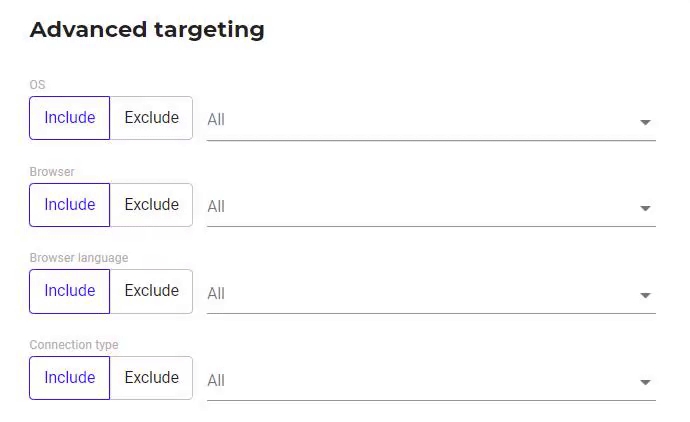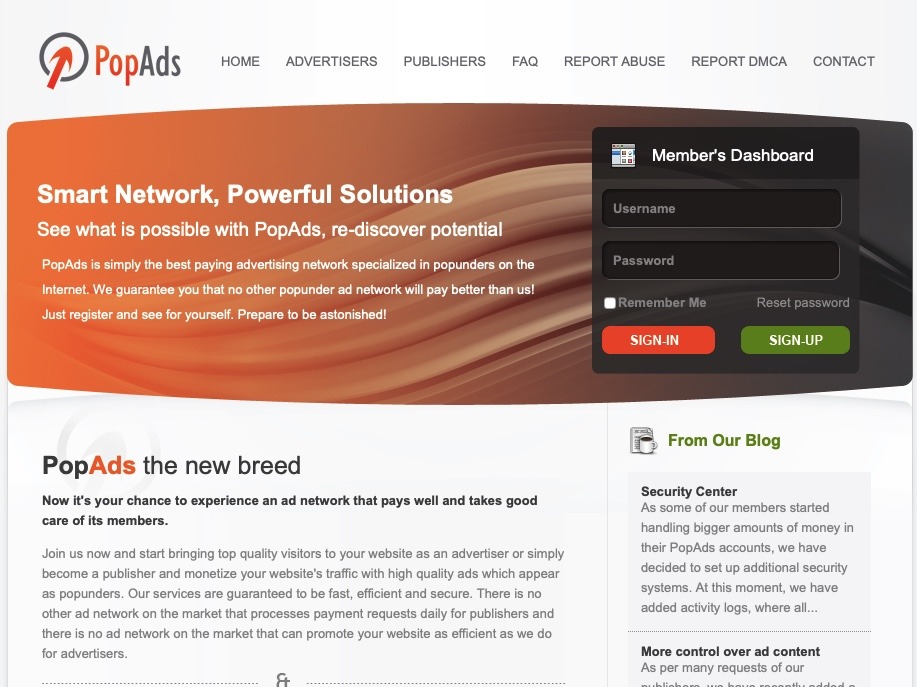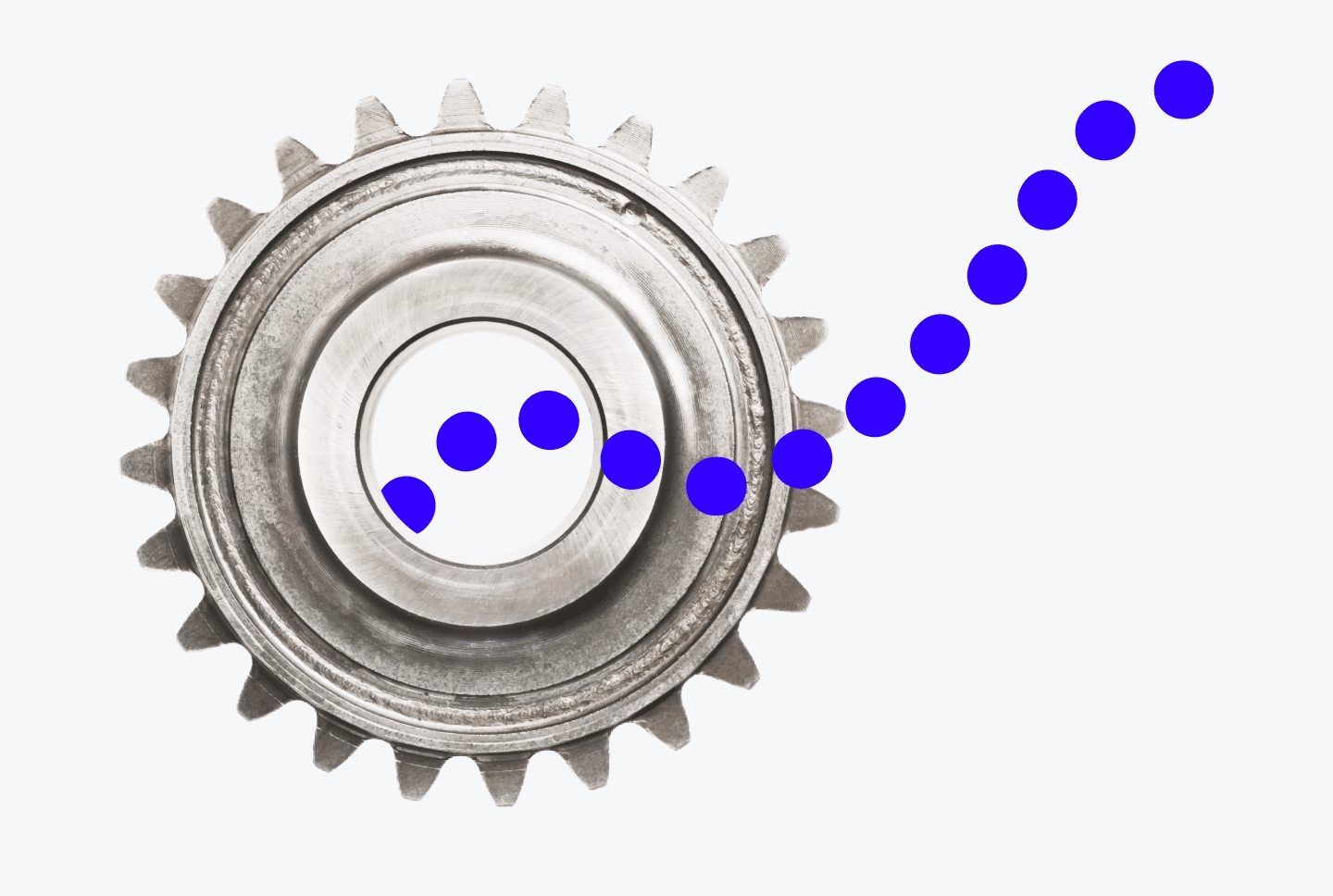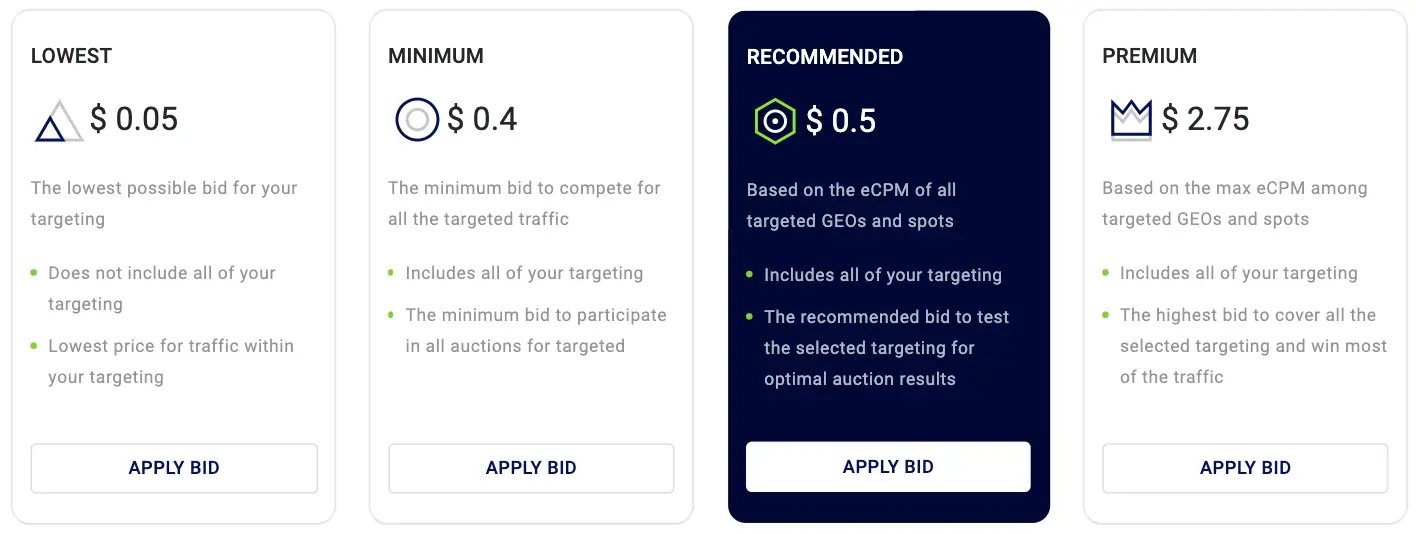Maximizing Your Advertising Strategy by Enhancing Your Understanding of Popads CPM Rates
Buy CPC Traffic | Buy Display Ads | Exclusive traffic sources | Buy Push Ads | Popunder ADS | Buy Native Ads | Buy Preroll Ads

Buy CPC Traffic | Buy Display Ads | Exclusive traffic sources | Buy Push Ads | Popunder ADS | Buy Native Ads | Buy Preroll Ads
When it comes to online advertising, understanding CPM (Cost Per Mille) rates is crucial for maximizing your advertising strategy and driving the desired results. Popads CPM rates, in particular, play a significant role in determining the cost of advertising on the Popads platform.
Popads is a popular advertising network known for its pop-under ads that can generate high-quality traffic and boost conversions. However, to make the most out of your Popads campaigns, you need to have a clear understanding of how the CPM rates work and how you can optimize your advertising strategy accordingly.
CPM rates refer to the cost an advertiser pays for every thousand ad impressions delivered to the targeted audience. Understanding how these rates are calculated and what factors influence them is essential for making informed decisions about your advertising budget and maximizing the return on investment (ROI).
In this article, we will explore the factors that affect Popads CPM rates and share valuable tips on how to optimize your advertising strategy to achieve better results. Whether you are a beginner in online advertising or an experienced marketer looking to enhance your campaigns, this article will provide you with actionable insights to take your Popads advertising to the next level.
What are Popads CPM Rates?
Popads CPM (Cost Per Mile) rates are a key metric in the world of online advertising. CPM is a measure of how much an advertiser will pay for every thousand impressions of their ad. Popads, a popular ad network, offers CPM as one of their pricing models.
When it comes to Popads, the CPM rates vary depending on various factors like the geographic location of the traffic, device targeting, and the type of ad being displayed. Advertisers bid on the available traffic with their desired CPM rates, and the highest bidder gets their ad displayed.
Popads CPM rates are influenced by several factors. One such factor is the quality of the traffic. Popads allows both mainstream and adult traffic, and the CPM rates for adult traffic tend to be higher due to its demand. However, it's essential to note that Popads has strict guidelines regarding the type of content allowed, ensuring that the ads remain compliant and safe for the users.
Another factor that affects Popads CPM rates is the targeting options available. Popads has various targeting options, such as country targeting, device targeting, and category targeting. Advertisers can choose specific countries to target their ads or choose specific devices, such as mobile or desktop. The CPM rates may vary based on the level of targeting and the demand for that particular audience or device.
To maximize the effectiveness of your Popads CPM rates, it's crucial to optimize your advertising strategy. This can be done by closely monitoring and analyzing your campaign data, including impressions, click-through rates, and conversions. By identifying patterns and trends, you can make informed decisions to adjust your bidding strategy and target the right audience. Additionally, it is advisable to test different ad creatives, landing pages, and call-to-actions to find the winning combination that generates the best results.
In conclusion, Popads CPM rates are an important aspect of online advertising. Understanding and optimizing your CPM rates can lead to increased visibility, higher click-through rates, and improved return on investment. If you're looking for targeted traffic and higher CPM rates, consider exploring rtb advertising, which provides real-time bidding options and advanced targeting features to enhance your ad campaigns.
Understanding CPM and its Importance

CPM, or cost per thousand impressions, is a commonly used metric in the advertising industry to determine the cost of reaching a thousand potential customers or viewers. It is calculated by dividing the total cost of an advertising campaign by the number of impressions, and then multiplying the result by 1000.
The CPM rate represents the cost that advertisers pay for every thousand ad impressions served, regardless of whether or not the user engages with the ad. It is an important metric because it allows advertisers to compare different advertising campaigns and determine which ones are more cost-effective.
CPM rates can vary greatly depending on factors such as the type of advertising platform used, the target audience, and the ad format. Popads, for example, offers different CPM rates for different ad formats, including popunders, tabunders, and banners.
Understanding CPM rates is crucial for advertisers to optimize their advertising strategy. By analyzing CPM rates, advertisers can identify trends, make data-driven decisions, and allocate their advertising budget effectively. A low CPM rate may indicate that an ad campaign is reaching a large number of potential customers at a relatively low cost, while a high CPM rate may suggest that adjustments need to be made to improve the campaign's reach and cost-effectiveness.
Furthermore, by monitoring CPM rates, advertisers can identify opportunities to optimize their ads or targeting strategies. For example, if a certain ad format consistently delivers a high CPM rate, advertisers may consider testing different formats or targeting options to improve the performance of their campaigns.
In conclusion, understanding CPM and its importance is essential for advertisers aiming to optimize their advertising strategy. By analyzing CPM rates and making data-driven decisions, advertisers can ensure that their campaigns are reaching the right audience at the right cost, ultimately maximizing their return on investment.
Factors Affecting Popads CPM Rates
Popads CPM rates, or the cost per thousand impressions, can vary depending on a variety of factors. Understanding these factors can help you optimize your advertising strategy and potentially increase your revenue. Here are some key factors that can affect Popads CPM rates:
1. Ad Placement

The placement of your ads can have a significant impact on CPM rates. Ads placed in premium positions, such as above the fold or in prominent areas of a webpage, tend to attract higher CPM rates. These positions often receive more visibility and engagement from users, making them more valuable to advertisers.
2. Ad Format

The format of your ads can also influence CPM rates. Certain ad formats, such as video or interactive ads, tend to command higher CPM rates compared to display or text-based ads. This is because these formats are more engaging and can offer a better user experience, which advertisers are willing to pay a premium for.
3. Audience Targeting
The audience you are targeting with your ads can impact CPM rates. Ads that are targeted to a specific demographic or interest group are often more valuable to advertisers because they have a higher chance of reaching their desired audience. Targeted ads can result in higher engagement and conversion rates, leading to higher CPM rates.
4. Ad Quality
The quality of your ads is another important factor that affects CPM rates. Well-designed, visually appealing ads with compelling content are more likely to attract user attention and generate clicks. Advertisers value high-quality ads as they can help improve their brand image and drive better results, resulting in higher CPM rates.
In conclusion, optimizing your Popads CPM rates involves considering factors such as ad placement, format, audience targeting, and ad quality. By understanding and leveraging these factors, you can improve the performance of your ads and potentially increase your revenue.
Target Audience and Geographical Location

When it comes to optimizing your advertising strategy on Popads, understanding your target audience and their geographical location is crucial. By targeting the right audience in the most relevant geographical locations, you can maximize the effectiveness of your campaigns and achieve higher CPM rates.
One way to target your audience effectively is through rtb advertising, which stands for Real-Time Bidding. With RTB, you can bid on ad impressions in real-time, allowing you to reach your target audience precisely when and where they are most likely to engage with your ads.
Understanding Your Target Audience
Identifying your target audience involves understanding their demographics, interests, and behavior. By analyzing data and insights from your website analytics, social media engagement, and past advertising campaigns, you can gain valuable information about your audience's age, gender, interests, and preferred devices.
For example, if your target audience consists of tech-savvy millennials interested in fashion and beauty, you can create ad campaigns that resonate with their interests and preferences. By tailoring your messaging and creatives to speak directly to your target audience, you can increase the chances of engagement and conversions.
Optimizing Based on Geographical Location
Geographical location is another crucial factor in optimizing your advertising strategy. By targeting specific geographical areas, you can ensure that your ads are seen by users who are most likely to be interested in your products or services.
For instance, if you have an e-commerce store that only ships within the United States, it wouldn't make sense to target audiences in other countries. By focusing on users located within your shipping areas, you can increase the relevancy and effectiveness of your ads, leading to better CPM rates and campaign performance overall.
Keep in mind that CPM rates can vary based on geographical location. Certain regions may have higher competition among advertisers, resulting in higher CPM rates. By monitoring and analyzing your campaign performance in different geographical locations, you can adjust your bids and targeting to maximize your ROI.
Quality and Relevancy of Ad Content

When it comes to running an effective advertising campaign on Popads, the quality and relevancy of your ad content are crucial factors that can significantly impact your CPM rates. Advertisers need to ensure that their ad content is engaging, informative, and tailored to their target audience in order to achieve the best results.
One important aspect to consider is the design of the ad. It should be visually appealing, easy to understand, and eye-catching enough to capture the attention of users. Using high-quality images, clear and concise text, and a compelling call-to-action can go a long way in increasing the overall effectiveness of your ad.
Furthermore, the relevance of your ad content to your target audience is key. Popads uses advanced targeting options that allow advertisers to target specific demographics, locations, and user behavior. By ensuring that your ad content aligns with the interests and needs of your target audience, you can maximize the chances of attracting clicks and conversions, ultimately resulting in higher CPM rates.
Engaging and Informative Ad Copy
Another essential aspect of ad content is the copy. Advertisers should focus on creating ad copy that is engaging, informative, and concise. Use strong and persuasive language to highlight the benefits and unique selling points of your product or service. However, be careful not to go overboard with excessive hype or misleading claims, as this can lead to negative user experiences and lower ad performance.
It's also important to constantly monitor and analyze the performance of your ad campaigns. Identifying the ads that are performing well and those that are underperforming can provide valuable insights for optimizing your advertising strategy. By regularly testing and refining your ad content, you can continue to improve your CPM rates and overall campaign performance.
Conclusion
By focusing on the quality and relevancy of your ad content, you can optimize your advertising strategy and improve your CPM rates on Popads. Engaging design, informative ad copy, and targeted audience segmentation are vital components of a successful ad campaign. Continuously monitor and analyze your campaign's performance to make data-driven improvements and drive better results.
Seasonal Trends and Demand
The success of an advertising campaign is highly influenced by seasonal trends and the resulting changes in demand. Understanding these trends is crucial for optimizing your advertising strategy on Popads.
During certain times of the year, such as holidays or shopping seasons, there is a significant increase in consumer demand for specific products or services. This spike in demand creates opportunities for advertisers to target a larger audience and achieve higher conversion rates. For example, during the holiday season, people are more likely to search for gift ideas or discounts, making it an opportune time to promote relevant products or services through Popads.
Researching Seasonal Trends
To effectively capitalize on seasonal trends and demand, it is essential to conduct thorough research. Start by analyzing historical data to identify trends and patterns in your industry. Look for recurring spikes in demand during specific times of the year and take note of any associated events or holidays. Understanding when your target audience is most likely to be interested in your products or services will help you plan your advertising campaigns accordingly.
Customizing Your Ad Campaigns
Once you have identified the seasonal trends and demand patterns that align with your business, it's time to customize your ad campaigns on Popads. Consider creating specific ad copy and visuals tailored to the season or event, incorporating relevant keywords and imagery that resonate with your target audience during that time. Highlight any promotions, discounts, or limited-time offers that can catch the attention of potential customers seeking seasonal deals.
Additionally, monitor and analyze the performance of your ad campaigns throughout the season. Adjust your targeting, ad placements, and bidding strategies based on real-time data and feedback to maximize your return on investment. Continuously optimizing your campaigns as you gather more data will help you stay ahead of the competition and make the most of the seasonal trends and demand.
Optimizing Your Advertising Strategy
When it comes to advertising on Popads, optimizing your strategy is key to maximizing your campaign's success. Below are some tips for optimizing your advertising strategy:
1. Define Your Target Audience
Before launching your campaign, it's important to clearly define your target audience. Consider factors such as demographics, interests, and buying behavior. By understanding who your audience is, you can tailor your ads to better resonate with them and increase the chances of conversions.
2. Choose the Right Ad Format

Popads offers various ad formats, including pop-under ads, pop-ups, and interstitial ads. Each format has its own advantages and may perform differently depending on your target audience and campaign objectives. Test different formats to see which one yields the best results for your campaign.
3. Optimize Your Landing Page
Ensure your landing page is optimized for conversions. It should have a clear call-to-action, relevant content, and a user-friendly design. Test different landing page variations and monitor the performance to identify what works best for your audience.
4. Monitor and Adjust Your Bids
Regularly monitor the performance of your campaign and adjust your bids accordingly. If a particular placement or targeting option is not performing well, consider lowering your bids or excluding it from your campaign. Similarly, if you notice a high-performing placement or targeting option, consider increasing your bids to maximize your exposure.
5. Split Test Different Ad Creatives

Experiment with different ad creatives to find the ones that resonate most with your audience. Test different headlines, images, and call-to-actions to identify what drives the highest click-through rates and conversions. Continually iterate and optimize your ads based on the results of your split tests.
6. Analyze and Optimize Your Results
Regularly analyze your campaign results to identify areas for improvement. Look for patterns or trends in your data and adjust your strategy accordingly. Analyze metrics such as click-through rates, conversion rates, and cost per conversion to understand the effectiveness of your campaign and make data-driven optimizations.
Click-through Rate (CTR)
The percentage of people who click on your ad after seeing it.
Conversion Rate
The percentage of people who complete a desired action, such as making a purchase or signing up for a newsletter, after clicking on your ad.
Cost per Conversion
The average cost you incur for each conversion. It's calculated by dividing the total cost of your campaign by the number of conversions.
By following these optimization tips and continually monitoring and adjusting your strategy, you can improve the performance of your advertising campaign on Popads and achieve your desired results.
Experimenting with Different Ad Formats
When it comes to optimizing your advertising strategy on Popads, experimenting with different ad formats can help you find the ones that work best for your campaign goals. Here are a few ad formats that you can try:
Popunder Ads: Popunder ads open in a new window or tab behind the main browser window, making them less intrusive. They can be effective in grabbing users' attention without disrupting their browsing experience.
Popup Ads: Popup ads appear on top of the current browser window and can be more visually engaging. However, they may be more intrusive to users, and it's important to ensure that they don't disrupt the user experience.
Tab-up Ads: Tab-up ads appear as smaller windows that slide up from the bottom of the browser window. They can be less intrusive than popups but still grab users' attention effectively.
Direct Link Ads: Direct link ads take users directly to the advertiser's landing page without opening any new windows or tabs. They can provide a seamless user experience and generate high-quality traffic.
Interstitial Ads: Interstitial ads are full-page ads that appear between content pages. They can be highly engaging but may interrupt the user's browsing experience. It's essential to display them at strategic moments to avoid frustration.
By testing different ad formats, you can understand what resonates most with your target audience and drives the best engagement and conversions. Remember to analyze the performance metrics of each format, such as click-through rates, conversion rates, and cost per conversion, to make data-driven decisions and optimize your advertising strategy on Popads.
What are Popads CPM rates?
Popads CPM rates refer to the cost per thousand impressions that advertisers pay on the Popads advertising platform.
How can I optimize my advertising strategy on Popads?
To optimize your advertising strategy on Popads, you can try different ad formats, target specific demographics, adjust your bidding strategy, and continuously monitor and analyze your campaign performance.
What factors affect the CPM rates on Popads?
Several factors can affect the CPM rates on Popads, including the quality and relevance of your ads, the targeting options you choose, the competition from other advertisers, and the overall supply and demand for ad inventory on the platform.
How can I improve the CPM rates for my ads on Popads?
To improve the CPM rates for your ads on Popads, you can focus on creating compelling and engaging ad creatives, optimizing your targeting options, and continuously testing and refining your campaigns to find the most effective strategies.
Are Popads CPM rates fixed or do they fluctuate?
Popads CPM rates can fluctuate depending on various factors, such as the time of day, the day of the week, the seasonality of the advertising market, and the overall demand for ad inventory. It is important to regularly monitor and adjust your campaigns to adapt to these fluctuations.
What are Popads CPM rates?
Popads CPM rates refer to the cost per 1,000 impressions that advertisers pay when using the Popads advertising network. It is a measure of how much an advertiser is willing to pay to have their ad viewed 1,000 times.
How can I optimize my advertising strategy for Popads?
To optimize your advertising strategy for Popads, you can start by targeting specific geographic locations that are more likely to generate conversions. You can also experiment with different ad formats and creatives to see which ones perform better. Finally, you can track and analyze the data to make data-driven decisions on how to best allocate your budget.
Is Popads a good advertising network?
Popads can be a good advertising network for certain types of advertisers. It has a large inventory of publishers and can reach a wide audience. However, the success of an advertising campaign on Popads will depend on various factors such as the target audience, the quality of the ad creatives, and the relevance of the offer to the target audience.
Are Popads CPM rates competitive compared to other advertising networks?
Popads CPM rates can vary depending on various factors such as the target audience, the ad format, and the competition in the specific niche. In general, Popads CPM rates can be competitive compared to other advertising networks, especially for certain niches or geographic locations.
How can I increase my CPM rates on Popads?
To increase your CPM rates on Popads, you can try improving the quality and relevance of your ad creatives, targeting more valuable audiences, or optimizing your bidding strategy. It is also important to track and analyze the performance of your ads to identify any areas for improvement and make data-driven decisions.
Buy CPC Traffic | Buy Display Ads | Exclusive traffic sources | Buy Push Ads | Popunder ADS | Buy Native Ads | Buy Preroll Ads
2022-2024 @ Understanding Popads CPM Rates: How to Optimize Your Advertising Strategy